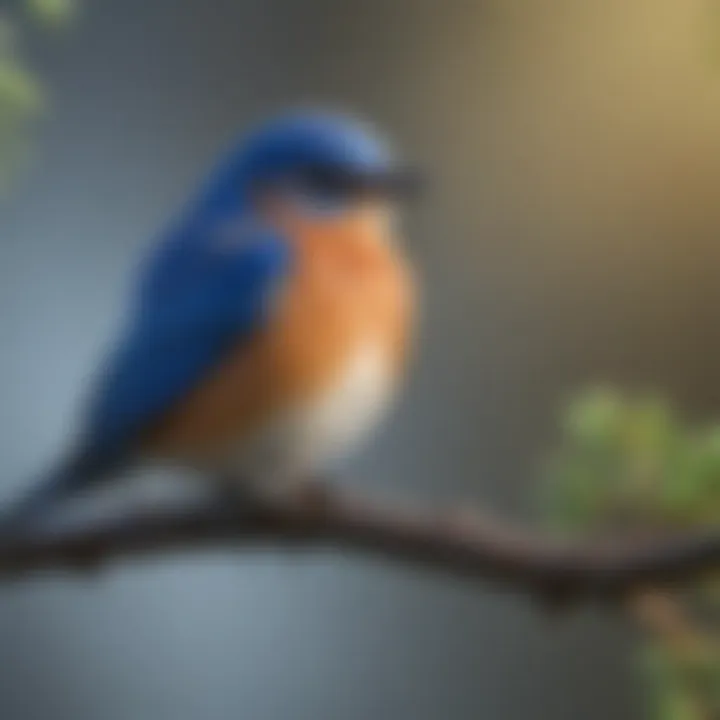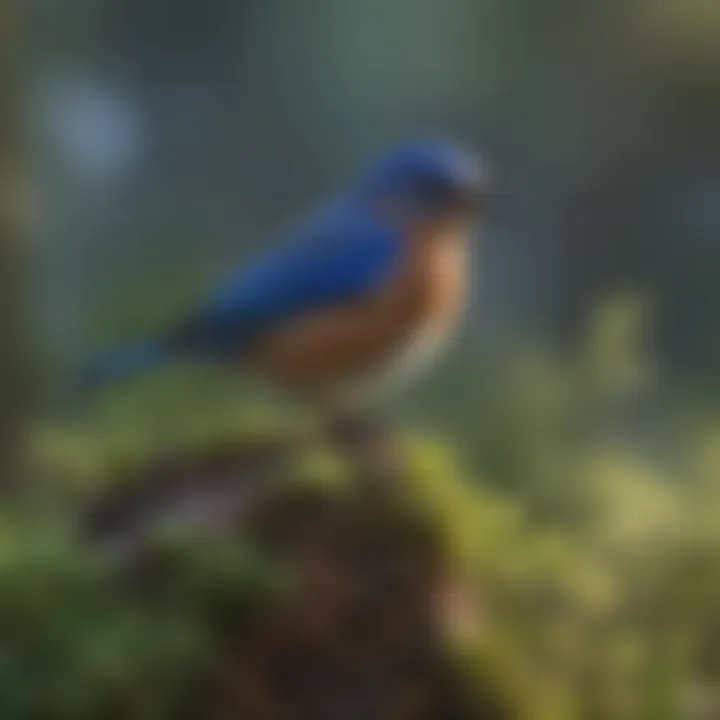Exploring the Lifespan of Bluebirds and Their Conservation


Overview of the Topic
In this section, we'll delve into why bluebirds are important, not just for ornithologists, but for everyone invested in the future of our natural resources. Several factors affect their lifespan, including habitat quality, diet, predation, and climate change—all of which tie directly into broader ecological issues.
Current Status and Challenges
As of recent observations, the populations of bluebirds are experiencing fluctuations. Habitat destruction, particularly through urban development and agricultural expansion, poses a significant threat.
- Loss of Habitat: The increasing urbanization and the conversion of forests into farmland have dramatically decreased the available living spaces for bluebirds.
- Climate Change: Altered weather conditions affect food availability, breeding cycles, and migratory patterns. For instance, milder winters may lead to earlier breeding, causing mismatches in food supply once chicks hatch.
- Predation: Rising predator populations, like cats and raccoons, have become more prevalent in areas where bluebirds once thrived.
These factors not only influence their survival but also spark important implications for conservation efforts. If we don’t address these issues, we may find ourselves in troubling waters.
Sustainable Solutions
To combat the challenges bluebirds face, various sustainable practices can be adopted.
- Habitat Restoration: Enhancing or creating bluebird-friendly habitats can promote their survival. This includes planting native vegetation, which supports not just bluebirds, but many species that share the same ecosystem.
- Nest Box Programs: Encouraging the use of nest boxes has led to successful breeding in many areas. Communities can get involved by putting up bluebird boxes and participating in monitoring programs.
- Public Awareness Campaigns: Informing the public about the importance of preserving natural habitats and the role of bluebirds in the ecosystem is paramount.
An example of effective resource management includes the initiatives led by local bird conservation groups which demonstrate how habitat restoration and community engagement can lead to population rebounds.
Impact and Importance
The ramifications of bluebird longevity extend beyond their immediate surroundings. Healthy bluebird populations contribute to insect control and seed dispersal, vital functions that maintain biodiversity.
The importance of conservation efforts cannot be overstated. By protecting the environments where bluebirds live, we protect countless other species and promote overall ecological balance. Successful conservation strategies not only lead to healthier bluebird populations but also signify the health of our ecosystems at large.
"By understanding the intricacies of species like the bluebird, we unlock doors to richer biodiversity and more resilient environmental systems."
Ending
As we further explore the specific influences on bluebird lifespan in this article, we aim to shed light on methods and practices to improve their odds of survival. Together, let’s aim for a world where bluebirds can thrive alongside us.
Prelude to Bluebirds
Bluebirds are more than just a pretty sight flitting across fields and gardens. As integral threads in the tapestry of ecosystems, they play a crucial role in pest control and seed distribution. Understanding bluebirds not only enhances our appreciation for their beauty but also illuminates their importance in maintaining biodiversity. This section sets the stage for a deeper dive into the lifespan of these birds, establishing a connection between their life cycle, habitat choices, and the broader ecological fabric.
Their cheerful song and vibrant plumage make them a favorite among birdwatchers. But their significance extends beyond aesthetics. Bluebirds serve as indicators of environmental health; changes in their populations often signal shifts in habitat quality or climate conditions.
Species Overview
In the realm of avian species, bluebirds belong to three main categories: eastern bluebirds, western bluebirds, and mountain bluebirds. Each of these species showcases distinctive traits that adapt to their environments.
- Eastern Bluebird: Known for its rich blue back and rusty throat, these birds prefer open fields and are often found in gardens and orchards.
- Western Bluebird: Interestingly, the western counterpart has a more subdued coloration, with males showcasing a more orange hue.
- Mountain Bluebird: As the name suggests, this species can be spotted in mountainous regions, with a striking sky-blue coloration.
These species not only differ in appearance but also in their behaviors and habitat preferences, shaping their lifespans in varying environments.


Cultural Significance
Throughout history, bluebirds have been woven into the cultural fabric of many societies. In literature and folklore, they symbolize happiness, love, and hope. American folklore often regards them as harbingers of good fortune, which illustrates their profound impact on human perception. In various Native American cultures, bluebirds are seen as bearers of good tidings and messengers of change.
Their allure has influenced art and music too. Many songs, poems, and artworks draw inspiration from their beauty, reiterating their role as significant icons in human culture.
With such rich cultural relevance, studying bluebirds provides insights not only into their biology and ecology but connects us to our shared environment and heritage.
Lifespan of Bluebirds
Average Lifespan in the Wild
Bluebirds in their natural habitats typically have a lifespan that ranges between two to six years. Several pivotal elements can influence this average. Typically, most wild bluebirds living beyond their first year tend to survive for several seasons, with some reaching maturity at around two years old. Notably, environmental stressors like severe weather can markedly affect their survival rates, particularly during winter months when food sources may dwindle.
"The harshness of nature often dictates which birds thrive and which do not."
In addition to climate challenges, habitat quality plays an essential role. Areas rich in native plants usually harbor higher densities of insects, which are a primary food source for bluebirds. Thus, locations boasting ample food supply can extend the life expectancy of these birds. However, predation remains a constant threat. Species such as snakes and larger birds of prey serve as significant hazards that can reduce the lifespans of bluebirds in the wild.
Lifespan in Captivity
When bluebirds are kept in captivity, their average lifespan may increase significantly, often reaching eight years or more. This stark contrast can be attributed to controlled environments that mitigate risks encountered in the wild. Captivity means consistent access to food, medical care, and shelter from predators, all contributing to a longer life.
However, it's important to note that captivity doesn’t guarantee a life without challenges. A captive bluebird's wellbeing is heavily reliant on the care they receive. Poor diet or stress stemming from inadequate housing can shorten their lives despite lacking natural threats. Thus, it requires dedication from caretakers to create an environment that promotes health and longevity.
In summary, both wild and captive bluebirds have unique lifespans influenced by an array of factors. Understanding these dynamics sheds light on the requirements for their conservation and the importance of preserving their natural habitats.
Factors Affecting Lifespan
Environmental Impact
The environment where bluebirds reside is a critical determinant of their lifespan. Factors such as habitat quality, climate conditions, and availability of nesting sites profoundly affect their survival rates. For instance, bluebirds thrive in open woodlands, scrublands, and parks where they can easily find food and nesting materials. Poor habitat conditions, impacted by urbanization or agriculture, can lead to increased competition for resources.
Habitat fragmentation is another significant concern. When their living spaces become isolated due to human activities, bluebirds may find it harder to locate mates or food. Seasonal changes also matter greatly. Harsh winters or prolonged droughts can limit food availability, impacting their overall health.
"A strong environment acts as a protective shield, ensuring the survival of species within its fold."
Dietary Influences
Diet plays a vital role in bluebirds' health and longevity. These birds are insectivorous, primarily feeding on beetles, caterpillars, and other small insects during the breeding season. They also consume fruits and berries, particularly during migration and winter months. A steady supply of nutritious food is essential for maintaining their energy levels and supporting reproductive efforts.
Poor dietary conditions can lead to significant health issues, such as weakened immune systems and reduced reproductive success. In more urban areas, the introduction of pesticides can jeopardize their food sources. Consequently, maintaining a balanced diet is not just essential for individual birds but has far-reaching implications for population dynamics and ecological balance.
Predation and Threats
Predation is one of the chief threats to bluebird populations. Natural predators, such as snakes, hawks, and even domestic pets can prey on bluebirds, significantly shortening their lifespan. Birds that occupy lower strata are particularly vulnerable during nesting.
Beyond predation, other threats can adversely impact bluebird longevity. Habitat destruction, due to the encroachment of human settlement, poses a looming danger. Moreover, competition for nesting sites with other birds, like house sparrows, often contributes to declining bluebird populations. Monitoring these threats is essential to developing effective conservation strategies that will help ensure that bluebirds, as well as the ecosystems they inhabit, continue to thrive.


Comparative Lifespan Analysis
When we delve into the comparative lifespan analysis of bluebirds, we’re embarking on a journey that extends beyond mere numbers. This section highlights the nuances of how the longevity of bluebirds stacks up against other avian species, as well as how regional factors might shape these differences. Understanding such comparisons not only enriches our knowledge about the bluebird’s life but also opens the floor to discussions about broader ecological implications.
Bluebirds Versus Other Birds
Bluebirds are often celebrated for their vibrant plumage and melodious songs, but how do they measure up to their feathered counterparts in terms of lifespan? The average lifespan of a bluebird can hover around six to ten years in the wild, depending on various circumstances like habitat quality, available food sources, and predation risks.
Comparatively speaking, some smaller birds might have a shorter lifespan due to their heightened vulnerability to predators and harsher environmental conditions. For instance, sparrows typically live for around three to five years in the wild. Conversely, larger birds, such as eagles, can enjoy a lifespan that stretches beyond thirty years.
Factors contributing to these varying lifespans often include:
- Size: Generally, larger birds tend to have longer lifespans. This is likely because they face fewer natural threats and can fend for themselves more effectively.
- Diet: The nutritional quality of food available greatly impacts longevity. Bluebirds primarily feed on insects and berries, which provide essential nutrients promoting health.
- Habitat Stability: Birds that inhabit stable ecosystems generally show better longevity. Areas that experience frequent disruptions or habitat loss can decrease lifespan significantly.
These comparisons allow conservationists and researchers to ascertain the effectiveness of specific environments on bird populations. Evaluating how bluebirds fare in relation to their peers can inform habitat management strategies aimed at bolstering their survival.
Regional Variations
When discussing lifespan, one cannot ignore the influence of geography. The longevity of bluebirds can drastically change based on regional environmental conditions. For example, eastern populations of bluebirds might encounter different predator species and food availability compared to their western cousins.
Regions with ample food supply, such as those with abundant insects during breeding seasons, tend to support longer lifespans for bluebirds. In contrast, areas plagued by habitat degradation or pesticide use may see these birds struggling to make ends meet, ultimately impacting their lifespan.
Consider these key aspects affecting regional lifespan variations:
- Climate: More temperate climates often provide stability and year-round food sources, affecting the vitality of bluebirds.
- Altitude: Bluebirds in higher elevations may face harsher conditions, influencing their survival rates and reproductive success.
- Human Impact: Urbanization can alter landscapes, introducing new threats like collisions and habitat fragmentation.
Understanding these regional differences allows for tailored conservation measures that are sensitive to the specific needs and threats faced by bluebirds in diverse habitats. By synthesizing data on how these factors interplay, conservationists can develop targeted initiatives that promote the longevity of this cherished species.
"A nuanced understanding of avian longevity paves the way for effective conservation efforts and highlights the intricate web of life within ecosystems."
By piecing together these elements—comparing lifespans across species and tuning into regional variations—we create a richer context for the lifespan of bluebirds and a better framework for conservation initiatives geared towards preserving their populations.
Lifespan and Breeding
Understanding how lifespan interconnects with breeding is crucial when discussing bluebirds. The longevity of these birds can directly influence their reproduction rates, success in rearing young, and ultimately, their population sustainability. When we consider the lifecycle of bluebirds, it becomes evident that breeding habits and lifespan are two sides of the same coin.
Impact of Reproductive Success
Reproductive success among bluebirds is a key driver of their lifespan. Generally, the more successful individuals are at reproducing, the more chances they have to extend their lineage, which can enhance genetic diversity within populations. Successful breeding leads to healthy, thriving young birds that may also carry forward longevity traits. For instance, research indicates that bluebirds that consistently manage to rear multiple broods over their breeding season often exhibit better health overall than those with lower reproductive rates.
But it’s not just the number of young produced; the survival rates of those offspring matter too. Bluebirds with an effective pair bond often see higher chances of fledgling survival. In some instances, a pair may even share duties in foraging and protecting their young from predators.
Certain environmental factors can also play a role here. Availability of nesting sites, food resources, and lower predation pressures can significantly impact their reproductive success. Bluebirds that inhabit areas rich in diverse flora tend to do better than those in less suitable habitats. To sum up, reproductive success not only fortifies population numbers but indirectly influences lifespan by promoting healthier, more resilient birds.
Parental Investment


Parental investment in bluebirds is another integral aspect of their breeding. This concept encompasses a range of behaviors, from choosing a safe nesting site to actively feeding the chicks. The energy and time that one or both adults devote to their young can dramatically affect survival rates. For instance, during the feeding period, both parents may engage in collecting insects and providing the protein-rich diet essential for the chicks.
Such investment bodes well for the health of the youngsters. A study once revealed that bluebird chicks that receive consistent attention from their parents are more likely to grow robustly and gain the necessary strength for fledging earlier than those that do not.
In instances of environmental stress—like a scarcity of food or increased predator risk—parental commitment becomes even more pivotal. Parents might forego their needs to prioritize the chicks, signaling a natural instinct that supports the continuation of their species.
As with reproductive success, the level of parental investment can directly influence lifespan. Bluebirds that thrive in nurturing environments with attentive parents are likely to live longer lives, allowing them to contribute back to their populations, thus creating a cycle that benefits future generations.
"The journey of a bluebird's life is not merely a function of time but an intricate web woven from their breeding practices and parenting efforts."
Significance of Lifespan Studies
From a conservation perspective, lifespan studies are paramount. They can unearth patterns of mortality that directly inform conservation efforts. For instance, if a specific area shows a concerning decline in lifespan due to pollution or habitat loss, that triggers immediate attention from environmentalists. The goal becomes not just to preserve bluebirds themselves, but rather to restore the health of that ecosystem, supporting a wider network of species.
Conservation Implications
Researching the lifespan of bluebirds leads to significant conservation implications. By linking the lifespan data to threats such as habitat degradation, climate change, and predation, conservationists can prioritize areas that need intervention. This information can also be invaluable for the development of conservation policies and effective management practices.
For example, if studies indicate that bluebirds are living significantly shorter lives in urban environments due to increased noise or light pollution, targeted strategies can be developed. These might include creating more wildlife-friendly urban spaces or reducing artificial lighting during migration periods.
Moreover, understanding the lifespan dynamics within populations allows for better assessment of species resilience. Healthy and long-lived bluebird populations often serve as indicators that a habitat is functioning well. Preservation efforts focused on boosting these populations could have cascading benefits throughout the ecosystem.
Biodiversity Indicators
Bluebirds, like other species, serve as sentinel species, meaning their health and longevity reflect the overall state of biodiversity. A thriving bluebird population typically suggests a rich environment, supporting not just avian life but a variety of organisms. Therefore, by examining their lifespan, we gather crucial data about the ecosystem’s richness and stability.
Longer lifespans in bluebirds could mean that their habitats have a balanced availability of resources such as food and nesting sites, suggesting a healthy environment. On the other hand, diminished lifespans may indicate ecological distress, possibly triggered by factors such as invasive species or habitat encroachment.
Thus, studying bluebird longevity serves a dual purpose: it illuminates the plight of one species while simultaneously acting as a barometer for broader environmental health. Taking into account these dimensions, lifespan studies don’t just aid in understanding bluebirds, they also foster a deeper comprehension of the interconnectedness of various species and their habitats, making a robust case for their conservation in today's changing world.
"Healthy bluebird populations can act as guardian angels for other species within their habitats, marking the balance of ecological systems."
In summary, grasping the significance of lifespan studies provides essential insights that not only benefit bluebirds but also contribute to our understanding of biodiversity and the necessities of conservation strategies.
Culmination
The exploration of bluebirds' lifespan offers significant insights into various ecological and conservation aspects that resonate not only with scientists but also the general public. Understanding how long these vibrant creatures live, both in their natural habitats and in captivity, places an emphasis on the delicate balance of their existence and the health of ecosystems at large.
Summary of Findings
After thoroughly investigating the lifespan of bluebirds, several key points emerge:
- Lifespan Variation: Bluebirds in the wild typically live up to 6 or 7 years, while those in controlled environments can reach even longer ages under optimal conditions. This stark contrast highlights how human intervention can impact wildlife longevity.
- Environmental Factors: The study identifies that habitat degradation, food supply, and climate conditions are significant determinants of bluebird lifespans. Deforestation and urbanization are particularly worrisome as they disrupt nesting sites and food sources.
- Challenges from Predators: Bluebirds face a variety of threats from predation to competing species, which can drastically lower their chances of living longer. Various studies have documented that lower predator presence can extend survival rates.
These findings underscore the importance of habitat conservation as a means to enhance the lifespan of bluebirds, making them a focus for environmental efforts.
Future Research Directions
Looking forward, there are plenty of avenues for future research that could further enrich our understanding of bluebird lifespans:
- Impact of Climate Change: More studies should focus on how shifting climate patterns affect bluebird habitats. Observing nesting success rates in correlation with rising temperatures or altered seasonal patterns could provide critical data.
- Health and Disease Management: Investigating the role of diseases in the mortality rates of bluebirds can help create better conservation strategies. An understanding of how health issues arise in the wild versus captivity can be beneficial.
- Genetic Studies: Examining genetic diversity among bluebird populations may reveal important data about resilience to environmental stressors. This can help inform breeding programs aimed at bolstering specific traits that contribute to longevity.
By carrying out these investigations, we can bolster our understanding and enhance conservation efforts not only for bluebirds but for other species as well in the context of biodiversity preservation.



